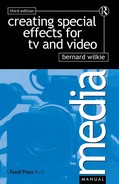Ray Guns and Blasters
Science fiction weapons conventionally demand more visual effects than ordinary hand guns, often being required to emit a beam of ‘energy’. The targets also differ from normal in that the rays do not terminate in pools of blood, but instead, generate effects ranging from wholesale mayhem to a few vicious sparks.
Weapons
The designs of ray guns and blasters differ from traditional hand guns in that they are usually bigger and have more external detail. Early examples were fitted with smoke effects and light flashing units, but these have been dropped in favour of smooth laser-type beams of light.
Ray effects
Yet another example of computer-generated effects, these rays are invariably added as a post-production operation. Applied in this way they can be made to move with the weapon, sweep in arcs and produce whatever destructive effect is considered appropriate.
Static ray
An early technique which might assist videomakers is one in which a black stencil containing a cut-out beam is super-imposed on a fixed weapon via the fifty-fifty mirror (page 26). When the two are lined up it is a simple matter to flash or sweep a light behind the stencil.
Target
Most ray-gun effects look good if the target erupts in a very conventional explosion. Methods of providing these are given on pages 102–110.
A further method of achieving a blast effect is to produce the blasted area in advance and then cover it with a removable membrane. For example, a cupboard door that has to be seared by the fearsome blast can be made of wood and the area required to be blasted hacked out with a chisel. Painted black and grey, a suitably devastated effect is implied. The treated door is then covered with self-adhesive wood-grain plastic sheet to make it look new.
To explode the area, a measure of gunpowder is applied to the sticky backing of the wood grain sheet before application, and a pyrofuse inserted through the back of the door to ignite it. The resultant explosion burns the sheet and blows it outward in a satisfactory searing effect.

1. Prepared damage
Expanded polystyrene gives a melted blast effect. This hole will then be provided with a small amount of gunpowder and a pyrofuse before being covered with self-adhesive vinyl sheet.
2. Zapped!
This is the result when the ‘wooden’ panel is supposedly hit by a blaster’s high-energy beam.
